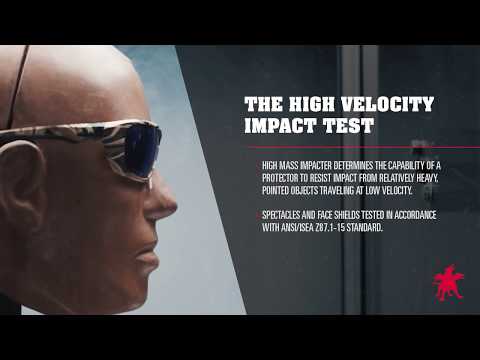MCR Safety doesn't expect you to put your life on the line based on third-hand promises of protection, which is why they test their products themselves. Their Innovations Technology Center (ITC Lab) has been in operation since 2010, testing PPE for cut, abrasion, heat, puncture, impact, and tear resistance. In July of 2016 their commitment to excellence led to the ITC becoming one of the first North American testing labs to receive ISO/IEC 17025 accreditation for Hand Protection, an international standard that requires companies to demonstrate a high degree of accuracy and consistency in testing protective equipment.
With the Bureau of Labor Statistics (BLS) reporting over 14,000 heat-related injuries each year, and many of those occurring around hot metal, the stakes are high. Despite the dangers of workplace heat-related injuries, the ITC’s heat-resistance testing is often a misunderstood process. Rest assured, they do not just run around sticking gloves in an oven to see what happens. ANSI 105-16 conductive heat-resistance testing standards guide every heat test conducted in the lab.
For those working in the Metal Fabrication and Primary Metals industries where hot metals and objects are everywhere, the ITC’s meticulous heat testing is a critical resource in selecting appropriate PPE.
Are you curious about burn injuries, the ITC heat testing process, and the best heat-resistant PPE? If you are, then you are in the right place. Below is an overview of what heat-resistance testing is and how heat-resistant safety gear can protect against related injuries.
Burns
The ITC’s heat-resistance testing serves an important purpose, not just for ensuring quality products but for those actually wearing heat-resistant gloves. Countless workers rely on MCR Safety gloves to protect them against workplace burns.
Burns usually happen by direct or indirect contact with heat, electricity, sun exposure, fires, or chemical agents.
There are three levels of burns:
This is an injury that affects the first layer of your skin, the epidermis, with minimal skin damage. Redness and minor inflammation are signs of this burn.
This is an injury that involves the outer and middle layers of skin, the epidermis and the dermis. Blisters will occur with this type injury and the skin will become extremely sore.
This is an injury that goes through the dermis and affects deeper tissues. Skin will become blackened and charred and the area may become numb.
Here are some of the many workplace activities and hazards that can cause burns:
Chemicals in laboratories
Contact with hot surfaces (A 2013 Michigan State study showed that 74 percent of all injuries came from thermal burns.)
Friction
Gasoline, hot tar, and grease
Heat from liquids like boiling water
Hot machinery, metal, and work pieces
Industrial cleaners, like rust removers and drain cleaners
Manufacturing workplaces
Molten metal
Open flames and explosions
Overheated electrical equipment
Sun exposure
What Does Conductive Heat Testing Actually Test?
There are a few important numbers when talking about conductive heat testing.
Time to Second-Degree Burn
This is the time that it takes a person wearing the PPE to develop second-degree burns when exposed to a given temperature. Second-degree burns, also known as partial-thickness burns, are those that cause blistering.
Time to Pain
This is the time it takes for a person wearing the PPE to feel pain when exposed to a given temperature. Pain is the body’s natural warning system that will cause a person to move their body part away from the heat source, lest they become burned.
Alarm Time
This is the amount of time between time to pain and time to second-degree burn. In essence, alarm time measures how long it takes someone to realize there’s a problem and to move away in order to avoid being burned. The longer they have before their body sounds the alarm, the safer they are from a potential burn.
How Do Conductive Heat Ratings Work?
Conductive heat ratings measure the highest contact temperature for which the time to second-degree burn is at least 15 seconds and the alarm time is at least four seconds. In other words, it is the maximum temperature at which you have at least 15 seconds before you are injured by the heat and at least four seconds of warning during which you can move away from the heat source and save your skin from burns. Again, the more time you have, the better your chances are of not getting seriously burned.
ASTM F1060-08 is the test method used in obtaining the following levels:
What Does This Mean For You?
It would be an oversimplification to say that you should always choose gloves with the highest heat safety ratings. After all, if you’re unlikely to interact with temperatures over 200°, it makes little sense to prepare for touching twice that heat level or higher. Most times, when someone requires added heat protection, the gloves’ weight increases, though this is not true in all instances.
And the focus on heat might come at the expense of other protection that is more pertinent to your work, such as cut or puncture protection. Therefore, an accurate assessment and job analysis of your responsibilities and activities will help to determine the appropriate PPE. Here are some of the factors that should be assessed: weight of the object, dexterity required, and handling time.
Once you’re familiar with the hazards of the work, including temperatures from both equipment and materials (including those left out in the sun), you can make a better decision about the levels of protection you really need.
Don’t Gamble When it Comes to Thermal Burns
MCR's ITC Lab serves as an important component of their quality control and product inspections by providing data to ensure compliance with product specifications. It also assures you’re wearing safety gear engineered to keep you safe from workplace hazards, such as hot objects.
Previously Featured on MCR Safety's blog.
To browse MCR's product line, visit MSCDirect.com.








